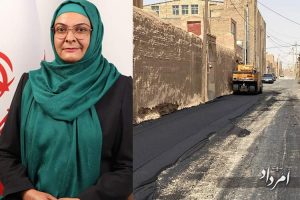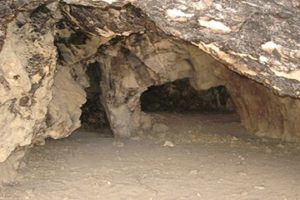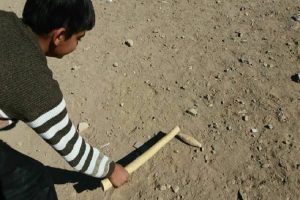The historic wall of “Ilkhani” garden in Shiraz was destroyed so that the loaders could enter this historic garden more easily. The job of these loaders is to remove the soil dug out from a trench to build kitchen and restaurant in the corner of this historic garden.
According to ISNA, nearly two weeks ago, the news of the destruction of the gateway of the Ilkhani garden in the historical context of Shiraz, with loader, was circulated. At the same time, the director general of the cultural heritage of Fars province denied it and said: “The gateway of the garden did not suffer any damage, and the wall of destroyed to build a service area based on the approved plan and with the coordination and supervision of the General Department of Cultural Heritage, Tourism and Handicrafts of Fars Province, and it has been agreed that the soil deposited in the open area of the western corner of the garden will be emptied in this way. The opening created in the corridor of the northwest corner is also for transporting (large volume of materials) and transferring the accumulated soil from the operation, and Fars Development and Construction Company (the project employer and the owner of the western front of Ilkhani Garden) is required, after completion of the restoration and repair work, to block this opening and restore the outer wall into its original state.”

Regarding the destruction of a part of the wall of the Ilkhani garden and the change of use of the garden, the opinion of cultural heritage experts is that although this event took place with the permission of the General Directorate of Cultural Heritage of Fars province, it can be said that it should be pointed out that this is not legal. As it is clearly stated in clauses “A” and “B” of Article 6 of the National Antiquities Preservation Law approved by the National Council of 1309 that “destroying or causing damage to national monuments and covering them with plaster or painting Inscriptions and lines on them, as well as taking actions in the vicinity of national monuments that cause the foundation to shake or change their appearance, are prohibited, and the perpetrators will be sentenced to pay a fine according to the court ruling, and in addition, the equivalent of the damage caused by the act to the national structures, can be charged to them.

Now, the main question is: If the entire wall collapses when destroying part of the wall, how this damage could be justified!
Excavation in the Ilkhani historical garden with the motive of adding a service section and also destroying the main wall of the garden and the room behind it (the age of which, in some sources, is attributed to the Zandiyeh era), undoubtedly violation of the law plus weakening the foundation of a historic structure. On this basis, issuing a permit to add a new structure within the framework of the service sector to this landmark building is not justified considering that the owner of the western part of Ilkhani garden has committed to the restoration and reconstruction of its old features.
However, the question comes up; why should a historical wall be destroyed so that loaders are comfortable to empty garbage and soil!
Even though the company in question is committed to rebuilding the destroyed historical wall after the end of the operation, the question is how can the weakened cohesion and identity be restored? Another issue that experts and activists of cultural heritage have raised is: What is the need for a building that has a gateway and its age goes back to the Zandiyeh period be destroyed so that they have to rebuild it later, considering that based on the interview with the responsible official, the new door is located close to the gateway.
On the other hand, this concern is raised; according to the use of tourism services defined for this mansion and garden, what guarantees this door will be removed and will not serve as a restaurant or tourist complex in the future?
On the other hand there is another concern since the use of this building and garden is changed to “tourism service” what guarantees this door will be removed and will not serve as a restaurant or tourist complex in the future?
Article 558 of the Islamic Penal Code (penalties and deterrent punishments) states: “Anyone who destroys all or part of buildings, places, grounds and cultural-historical or religious collections that have been registered in the list of national monuments of Iran, or decorations, Annexes, facilities, objects and accessories, calligraphy and motifs related to the above mentioned places, which independently also have cultural-historical or religious status, causing damage, in addition to compensating for the damages, will be sentenced to imprisonment from one to ten years.
In addition to the provisions of Article 564 and Article 564 of the Islamic Penal Code, Article 566 of the Islamic Penal Code clearly states that “Anyone who changes the way of using the buildings, places and religious-cultural and historical sites that are registered in the list of national monuments, contrary to the provisions of the work And without permission from the country’s cultural heritage organization, in addition to removing the effects of the violation and compensating for the damage, he will be sentenced to imprisonment from three months to one year.”
Bagh Ilkhani is accessible from North Qaani Street, at street NO. 21 and then street NO. 67/6, as well as from Koi Sengsiah and Koche Ghaghaliha. This garden is one of the structures built by Mohammad Qoli Khan Ilkhani Qashqai during the Qajar era. However. We can attribute the age of this garden to the Zandiyeh period, and Khan Qashqai built a mansion in the garden during the Qajar era. Some parts of this garden were separated years ago, and now the garden has become two eastern and western parts. The western part, where the primary and old building is located and has remained intact to some extent, had a brick headland with visible burn marks. The area of this section is 3500 square meters, but the garden’s main building is located east of it.
In the eastern part, there is a garden with an area of 3000 square meters, and the Kolah Ferangi mansion is also in this part. The brick building in this part of the Ilkhani garden has a porch with two columns, and a large hall with five doors is visible behind the porch. There is also a room in the upper part of the five doors. There are two corridors on both sides of the porch, and two earrings can be seen at the top of the corridor. There are three rooms in the north corner of the porch and four in the south corner. This mansion has 14 rooms. In front of the porch are two solid stone columns, the heads of which are carved like muqarnas. The flat roof of the porch is wooden, and inlay is used. A rectangular pond is built in front of the porch.
In front of the porch, there are five inlaid wooden doors. These doors open to a hall called five doors. The walls of this hall are also plastered. The wall of the mirror room, built in the south corner of the porch, is fully mirrored and plastered, and the ceiling wood is painted with a picture of a flower and a nightingale. A rectangular basin is built in front of the porch.
The entire garden is covered with trees. On both the eastern and western sides of the garden, the old entrance doors have been closed (blocked), and so far, there is no information about the state of the mansion and the garden. The western part of this building was owned by Fars Development and Construction Company years ago, and a private owner owns the eastern region, and the entrance to this part has been closed by the private owner for years. The western front also has a separate headland. However, the justification of the cultural heritage authorities is that access to it is limited. The historical wall of the garden has been destroyed. But, from the point of view of the cultural heritage experts, based on the intention and commitment to restoration that the investor has for this structure, he should have the debris and rubble removed from the same door.










